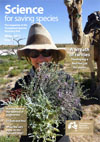Latest News
-

Finding the places where threatened species hide
Fri, 06 May 2016Places such as islands, river channel regions of the desert and small-scale rock outcrops can offer critical protection for threatened species populations when times get tough.
-

Tackling threats to endangered hollow nesting birds in Tasmania
Fri, 06 May 2016Sugar gliders in Tasmania are having a devastating impact on the swift parrot population, and they could be detrimental to other threatened bird species as well.
-

Big commitment to little species
Thu, 05 May 2016Researcher profile: Dr Diana Fisher has dedicated two decades to the study of mammals, including threatened species of carnivorous marsupials, wallabies and bats that most people know little about.
-

More data to tackle threats to Malleefowl
Thu, 05 May 2016Australia’s Malleefowl population has declined and more conclusive data will soon be available to explain why, following recent workshops in Perth and Mildura. The TSR Hub will conduct the first landscape-scale experiment investigating the effect of predator-baiting programs on Malleefowl populations.
-

National approach required for myrtle rust threat
Wed, 04 May 2016Australian environmental authorities will adopt a unified approach to combat myrtle rust, in the hope of preventing the devastating disease from spreading to Western Australia. The need for a more coordinated response was raised in a recent national workshop coordinated by the TSR Hub in April, amid concerns that previous efforts have been sporadic and ineffective.
-

Success, failure and lessons learned on Australian islands
Wed, 04 May 2016Australian islands have a vital role to play in protecting threatened species. By providing predator-free, relatively low-pressure environments, islands can act as sanctuaries for species at risk on the mainland. They also present novel conservation challenges and opportunities, and better information is needed on how to most effectively protect Australia’s island biodiversity.
-

The art of threatened species science
Wed, 04 May 2016A series of elegant watermarks have been created by science communicator and illustrator Michelle Baker, to reflect the major themes of the TSR Hub and will be integrated into future publications. The six watermarks, inspired by science and nature, provide a thematic or conceptual link between each image and its corresponding Hub theme.
-

Better offsets for threatened species
Wed, 04 May 2016When species are threatened by development such as urban growth or mining, environmental offsets are often used to help counterbalance the impact.
-

Measuring return on investment in threatened species recovery
Mon, 02 May 2016Whether it’s reducing hospital queues, improving social equity or recovering threatened species, taxpayers need to know their investment is producing results.
-

Keeping an eye and ear out for threatened species
Fri, 22 Apr 2016Sometimes the hardest part of protecting threatened species is knowing where to look, how to look, or how to listen, or when to launch a drone.
-

Partnerships with Indigenous communities key for threatened species
Wed, 30 Mar 2016Indigenous communities play a crucial role in Australian conservation for a number of reasons – the first being that numerous threatened species live on lands they own and manage.
-

Joining the dots: working together to protect our island network
Wed, 30 Mar 2016More than 8000 islands surround Australia’s coast - from tropical to temperate to sub-Antarctic climates; from large populated islands to tiny uninhabited offshore rocks.
-

Learning from success and extinction
Wed, 30 Mar 2016Australia has had remarkable success with saving species otherwise doomed to extinction – including the Kangaroo Island Glossy Black-Cockatoo, Norfolk Island Green Parrot and Gilbert’s Potoroo.
-

2020 target set for more threatened species
Mon, 28 Mar 2016Research outputs from Project 2.1 formed an important part of the Minister for the Environment’s Threatened Species Strategy, and supported the listing of 20 threatened birds and 20 threatened mammals as targets for priority conservation actions.
-

Framework for national safe haven network
Mon, 28 Mar 2016Australia will soon have a framework to design a national network of ‘safe havens’ for threatened mammals, following a recent workshop with 24 leading conservation specialists from federal and state governments, NGOs and academia.
-

Species on the move conference
Mon, 28 Mar 2016Threatened Species Recovery Hub researchers presented at the recent Species on the Move International Conference in Hobart, including Hub Director Hugh Possingham.
-

TSR contributes to Feral Cat Taskforce
Mon, 28 Mar 2016The involvement of deputy directors Sarah Legge and John Woinarski in the Threatened Species Commissioner’s Feral Cat Taskforce is another example of the Hub contributing significantly to threatened species policy and management.
-

Christmas Island a high priority for the Hub
Sun, 13 Dec 2015Unfortunately Christmas Island’s extremely unique ecosystem has experienced recent extinctions, with more species under threat.
-

Keeping up with biodiversity loss
Thu, 26 Nov 2015The Threatened Species Recovery Hub’s Project 2.1 will work to ensure that policy makers and project managers have more reliable and up to date information about species closest to extinction.
-

Strategic fire management can reduce extinctions
Sun, 22 Nov 2015Australia is one of the most fire prone continents on earth and our influence on fire regimes plays an important role in the ecology of our flora and fauna.
-

Threatened Species Recovery Hub to join fight against feral cats
Tue, 03 Nov 2015Feral predators such as cats and foxes have caused the extinction of many native mammals and remain the most serious threat to the remaining mammal species - especially when combined with mismanaged fire and introduced herbivores.
